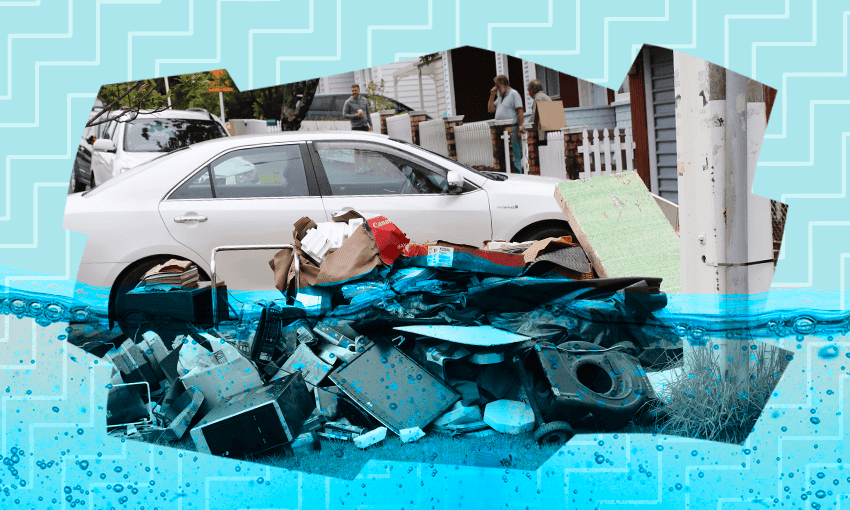What to do once the water levels recede and you’re allowed to return home.
Assess the damage
If you’ve safely evacuated your home from floodwaters, you’ll need to wait for Civil Defence to give you the OK to return. When you do, wear protective gear like gloves, a mask and protective overalls, advises Massey University senior lecturer Dr Mikael Boulic. Make sure your power supply is safe to use and turn it off at the mains if necessary. “Something people might not think to do straight away is to check the electrical safety – water and electricity don’t play nicely,” says University of Otago senior research fellow Dr Lucy Telfar Barnard. State Insurance advises having an electrician check the power supply before it’s turned back on.
Be wary of injury – your house probably won’t be in the same condition as you left it. “If you go back to a flooded house, be careful, there are a lot of potential hazards,” says Boulic. Take photos of the damage before you start cleaning up so you can include those with your insurance claims (more about that shortly). Most important of all: don’t let your kids splash about in floodwaters for fun. “It could be a very unhealthy environment if there is sewage overflow.”
(If you need emergency assistance, you can find details of how to find help here.)
Remove your damaged property
Once you’ve worked out which parts of your home are affected the most, it’s time to begin removing water-damaged property. State Insurance advises using a permanent market to make small marks on the wall to measure the maximum height of the water in every room affected by flooding. Drag out waterlogged bedding, clothes, furniture and household items, then rip up carpets. When floodwater is involved, the clean-up needs to be extensive and thorough, advises Bernard. “Floodwater tends to be contaminated with sewage and other nasties,” she says. “Any kind of absorbent building materials have got to go. If you have carpet or some kind of layered flooring, it may have to be replaced. That’s because it’s not just about the surface contaminants, but also what’s sitting underneath – and the smell that will not go away unless you do that.”
Keep your eyes open for mould
Time is of the essence here as mould can grow very quickly in the right conditions. “Mould grows according to temperature and relative humidity and often it is invisible,” says Boulic. “Your most effective weapon against it is to dry the house out as soon as possible.” If you have power, turn on air conditioning, heat pumps or dehumidifiers and close the windows. Or, open the windows and turn on “every fan you own” advises Boulic. If you’ve already got mould you’ll need the help of professional cleaners to sort out the problem. Take notes and photos of all mould damage for any future insurance claims.
Deal with your car
If your car was caught in the floodwater, don’t attempt to drive it again. “Water-damaged vehicles can be dangerous because they tend to lose function suddenly and air bags can deploy without warning,” cautions State Insurance. Tell your insurer immediately, and they’ll organise a tow truck so it can be properly assessed.
Contact your insurers
If you’re renting, alert the homeowner or property manager and give them a detailed list of all the damage. They’re responsible for maintaining the property and that includes fixing any flood damage, says Consumer NZ. If the property is damaged but liveable, you’re due for a rent reduction. If it’s uninhabitable, the tenant can give notice. “If the landlord doesn’t agree, you’ll have to go to the Tenancy Tribunal to have the lease ended,” advises Bernard. The tenant’s contents insurer will be responsible for replacing any property damaged during the flood.
If you’re a homeowner, you’ll need to contact your insurer asap. If you have private house insurance, you’ll qualify for EQCover which covers you for damage as a result of a storm or a flood. This will be managed through your insurer. Phone lines are likely to be busy so some insurance companies are allowing customers to lodge claims online first. Once you’ve compiled a list of damage and destruction, it may pay to do this.
It’s time to head to the tip
Auckland’s refuse stations are free for the near future for homeowners needing to get rid of damaged property. If you’ve got a trailer, or a mate with one, you might want to drag your drenched carpets and soggy homewares to the tip yourself. Queues are building and it’s advised you call ahead to see how busy they are first – more than 58 tonnes of stuff has already been taken to the Waitākere Transfer Station. Others are using skips that have been places in flood-prone communities. Auckland Council says kerbside collections are happening in “areas of need”. You can check for updates here.
Should you DIY?
If you can patch up your house to make it liveable again, this is allowed under “make safe” weathertight insurance rules. Windows, for example, can be boarded up if broken. Insurance companies warn you should document all of this, inform them of the work you’re doing, and engage a tradesperson wherever possible.
Look after yourself and those around you
This emergency isn’t over and isn’t likely to be for some days. If you can, remember to breathe, try and get something to eat and if you’ve got kids and pets nearby, reassure them at every possible opportunity. If you have capacity, check in on those around you. “Social connections help recovery, resilience, mental health and wellbeing, but not everyone has a social network they can turn to,” says University of Otago senior lecturer Dr Lesley Gray. “Think about your own neighbourhood – who lives alone, who rarely gets out and about, does anyone visit – can you offer any support? … The recovery from these massive flood events will take time, energy, resources.”
